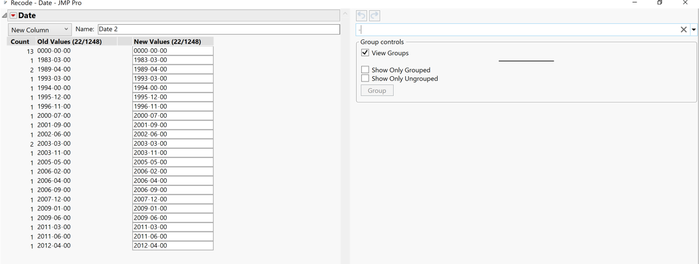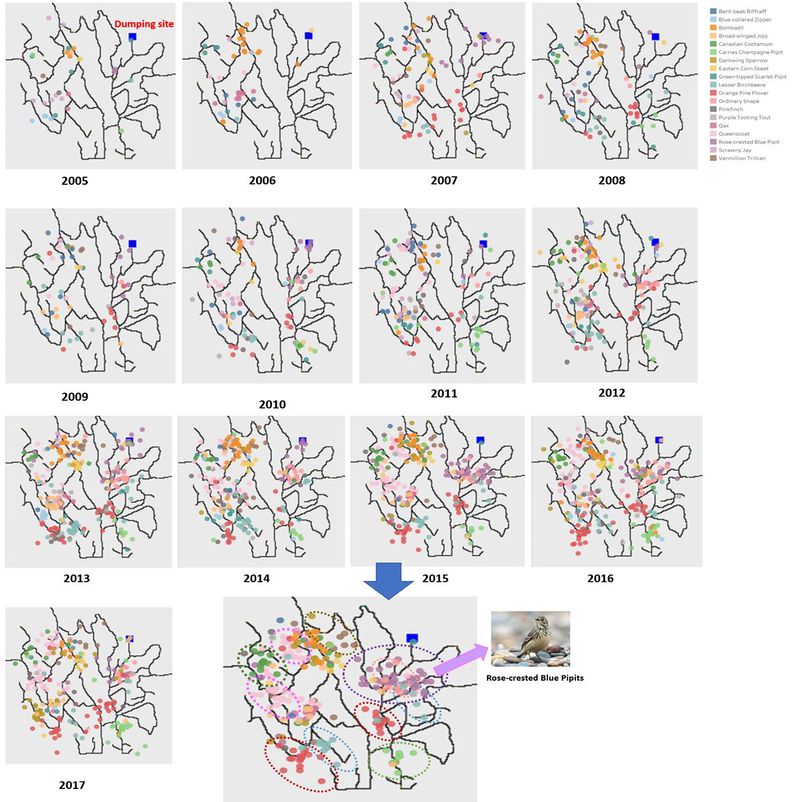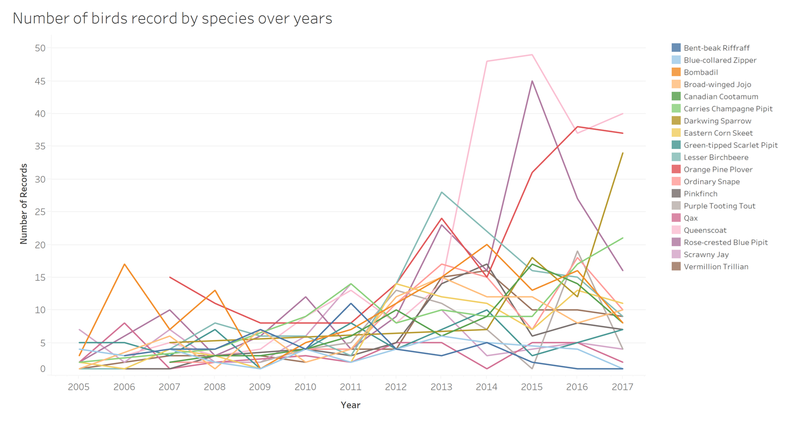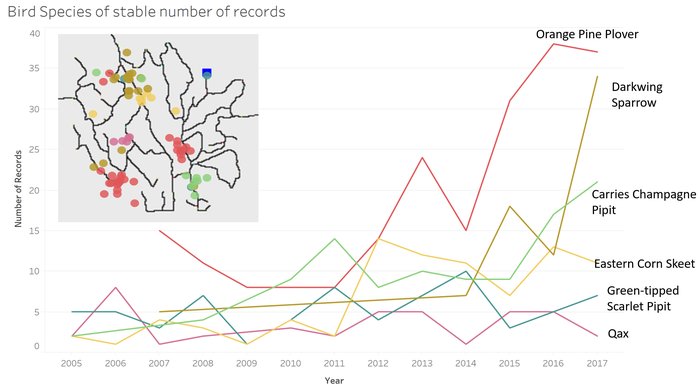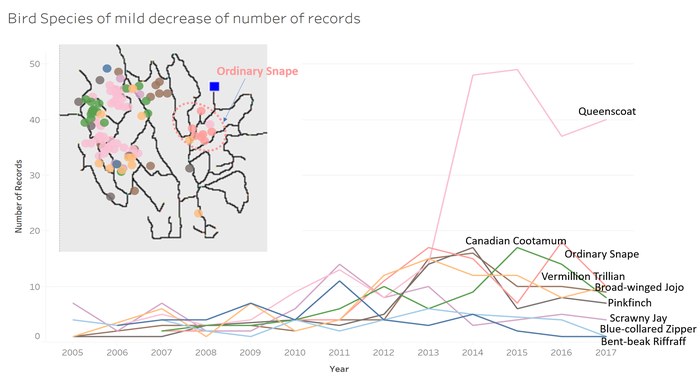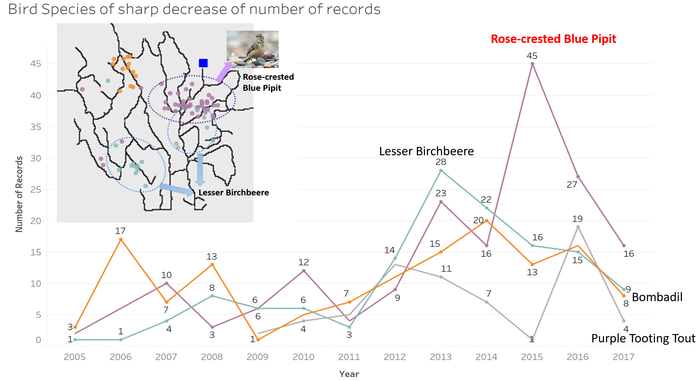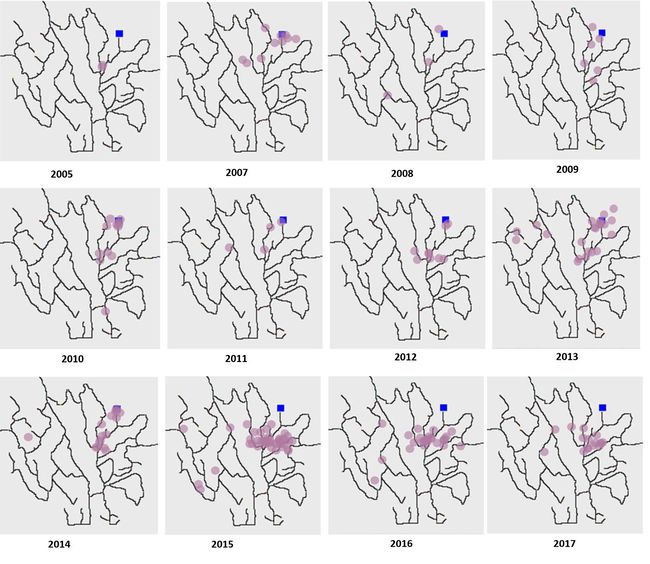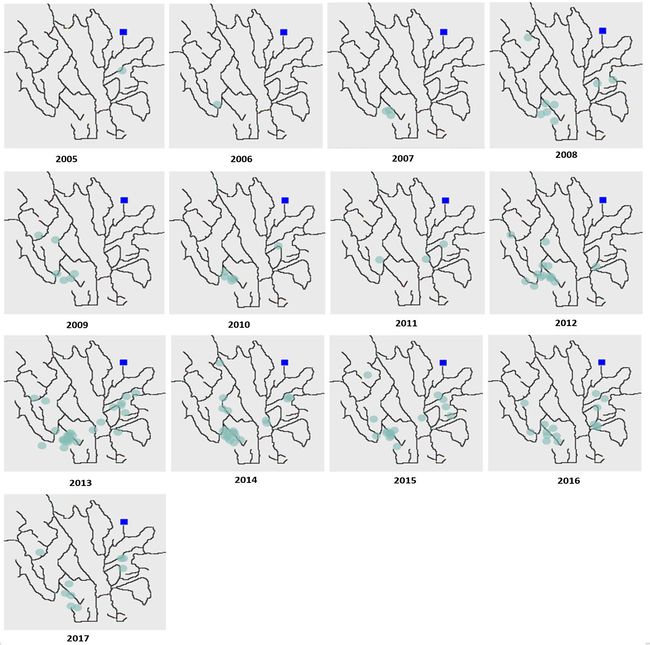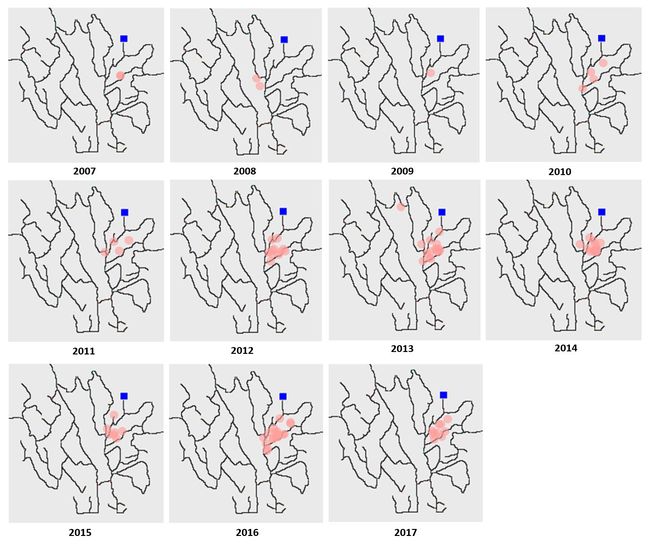ISSS608 2017-18 T3 Assign Zhang Yingdi Task1
|
|
|
|
|
|
|
The objective of this question is to use the bird call collection and the included map of the Wildlife Preserve, characterize the patterns of all the bird species in the Preserve over the time of the collection and detect if there are any trends or anomalies in the patterns. The analysis of this question is conducted in Tableau.
Tableau Dashboard
The Tableau dashboard can be accessed via the below link:
https://public.tableau.com/profile/zhang.yingdi#!/vizhome/MC1_ZYD/Dashboard1?publish=yes
Data Preparation
Import file AllBirdsv4.csv into JMP, in column Date, there are 13 records with values “0000-00-00”, these 13 records are considered as missing information and are removed from the dataset. Next, the date format in column Date is not standardized, most of the rows are in format mm/dd/yy. However, there some rows with different date format yyyy-mm-dd, all these records are recoded to format mm/dd/yy.
Change the data type of Date column from “Character” to “Numeric”, Modelling type from “Nominal” to “Ordinary”, Format to “m/d/y”.
Check and make sure there are no missing values in the Date column.
Next, check values in X and Y columns, there are two rows with “?” in the Y column, delete these two rows from the data table.
Data Analysis
To figure out if there is any trends or anomalies in the patterns of all of the bird species over the time of collection, we will first visualize the distribution of all bird species over the years of collection. Since the number of all bird species increase from 2005, there are only few number of bird records before year 2015, hence we will only use the data from year 2005 onwards, the data from year 2018 is also excluded since now is still in the mid of 2018 and there are not enough records collected for year 2018.
From the distribution of the all bird species over years, we can find that:
- The number of all bird species increase from 2005.
- With different colours indicating different bird species, it shows that over the years, different species of birds tend to form their own clusters instead of distributing all over the place randomly.
- From the distribution, it seems like the total number of bird’s records increase from 2005 to around 2016, then start to decrease. Now we will use line graph to find out if the number of bird's records indeed change like the observation from the distribution graph.
Below shows the line graph of the number of birds records by species over years.
From the line graph, we can see the change of number of records for different bird species over the years are different. The number of records for some of the species remains stable or increased over the years; some of the species have an increase of records around year 2013, then experienced a drop on the number of records. Where else, some of the species had a sharp increase of number of records around 2015 and have a relatively sharp decrease after 2015. With this observation, we will cluster the bird’s species according to their change patterns over the years of collection. The species are clustered to three clusters.
Cluster 1 – Bird species of stable number of records over years
This cluster contains the species that have a stable number or increasing number of record over the years of collection.
The line graph for the number of records of species belongs to this cluster are plotted, the location of these species are also plotted. From the graph, we can observe that for the species that have a stable number of records or increased number of records, their home range are all relatively far away from the dumping site.
Cluster 2 – Bird species of mild decrease of number of records
This cluster contains the species which have a mild decrease of number of records over the years of collection.
For the species that in this cluster, we can see that some of the species have a home range near to the dumping site. For example, number of species Ordinary Snape experienced a drop from 49 to 37 from year 2015 to year 2016.
Cluster 3 – Bird species of sharp decrease of number of records
This cluster contains the species that experienced a sharp decrease of number of records over the years of collection the records.
There are four species that have a sharp decrease of the number of records over the collection of years. They are Rose-crested Blue Pipit, Lesser Birchbeere, Bombadil, Purple Tooting Tout. There is a sharp drop of the number of records for Rose-crested Blue Pipit on 2016 and 2017. The number of records dropped from 45 to 27 on year 2016, and further dropped from 27 to 16 on year 2017. Besides, we can also observe that Lesser Birchbeere has also experienced a sharp drop on the number of records from year 2013 onwards. The number of records of Lesser Birchbeere dropped from 28 to 9 from year 2013 to 2017. Bombadil and Purple Tooting Tout also had a sharp decrease of number of records from year 2015 to year 2017.
We can see that both Rose-crested Blue Pipit and Lesser Birchbeere have a home range near the dumping site, hence, the dumping site may have been a primary contributor to the apparent reduction of the number of nesting pairs of the Rose-Crested Blue Pipit.
Next, to further investigate if the dumping site has a impact on the reduction of the number of Rose-Crested Blue Pipit. We will see for those species near the dumping site that experienced reduction, if their home ranges became further away from the dumping site over years. Based on the findings above, there species near the dumping site had a reduction of numbers over the years, they are Rose-crested Blue Pipit, Lesser Birchbeere and Ordinary Snape.
Home range for Rose-crested Blue Pipit over years:
We can see that over the years, the home range of Rose-crested Blue Pipit moves towards the dumping site from year 2005 to year 2013. However, they started to move away from the dumping site from 2014 onwards.
Home range for Lesser Birchbeere:
We can see that different from Rose-crested Blue Pipit, the home range of Lesser Birchbeere has a trend of moving towards the dumping over the years.
Home range of Ordinary Snape:
We can see that the home range of Ordinary Snape also has a trend of moving towards the dumping site over the years.
Out of the three species, only Rose-Crested Blue Pipit shows a trend of moving the home range further away from the dumping site over years, the other two species show a trend of moving the home range nearer to the dumping site over years. Moving away from the dumping site may be an indication that there is dumped process waste near the dumping site that is harmful to the Rose-Crested Blue Pipit, so they started to move away from the dumping site in 2014.
Lesser Birchbeere and Ordinary Snape had a trend of moving towards the dumping site might due to the unawareness of the harmful materials dumped, which cause a reduction for both of the two species. This finding further support that the dumping site may have been a primary contributor to the apparent reduction of the number of nesting pairs of the Rose-Crested Blue Pipit. In general, we can see that species which have home ranges nearer to the dumping site tend to have a higher chance of experiencing sharp reduction.
However, we should also note that the home range for Bombadil and Purple Tooting Tout are not near to dumping site, but they also experienced a sharp decrease of numbers over the years. Hence there might be other reasons that will cause the number of birds decrease besides the dumping site.

